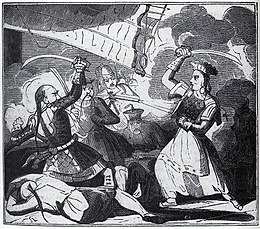
Back Dones pirates Catalan Femme pirate French Wanita dalam perompakan ID 여성 해적 Korean Gratë në pirateri SQ கடற்கொள்ளையில் பெண்கள் Tamil Жінки в піратстві Ukrainian 女海盗 Chinese

| Part of a series on |
| Women in society |
|---|
 |
Although the majority of pirates in history have been men,[1] there are around a hundred known examples of female pirates,[2][a] about forty of whom were active in the Golden Age of Piracy.[4] Some women have been pirate captains and some have commanded entire pirate fleets. Among the most powerful pirate women were figures such as Zheng Yi Sao (1775–1844) and Huang Bamei (1906–1982), both of whom led tens of thousands of pirates.[5][6]
In addition to the few that were pirates themselves, women have also historically been more heavily involved in piracy through secondary roles, interacting with pirates through being smugglers, lenders of money, purchasers of stolen goods, tavern keepers and prostitutes, and through having been family members of both pirates and victims.[1][7] Some women also married pirates and turned their homes or establishments into piratical safe havens.[8] Through women in these secondary roles, pirates were strongly supported by the agency of women.[9] Some influential women, including monarchs such as Elizabeth I of England (r. 1558–1603), have also acted as powerful patrons of pirates.[1] Although they have received little academic attention, women still occupy these important secondary roles in contemporary piracy. Piracy off the coast of Somalia is for instance supported to a large extent by on-shore women who participate in transportation, housing and recruitment.[10]
Seafaring in general has historically been a highly masculine-gendered activity.[11] Women who became pirates at times disguised themselves as men in order to do so since they were otherwise rarely allowed on pirate ships. On many ships in the Golden Age of Piracy, women were prohibited by the ship's contract (required to be signed by all crew members) due to being seen as bad luck and due to fears that the male crew members would fight over the women. Many famous female pirates, such as Anne Bonny (disappeared after 28 November 1720) and Mary Read (died April 1721), accordingly dressed and acted as men.[12] Since the gender of many pirate women was only exposed after they were caught, it is possible that there were more women in piracy than is otherwise indicated by surviving sources.[13]
In addition to historical female pirates, women in piracy have also frequently appeared in legends and folklore. The earliest legendary female pirate is perhaps Atalanta of Greek mythology, who according to legend joined the Argonauts in the years before the Trojan War.[14] Scandinavian folklore and mythology, though the tales themselves are unverified, includes numerous female warriors (shield-maidens) who command ships and fleets.[15] Female pirates have had varying roles in modern fiction, often reflecting cultural norms and traditions. Beginning in the 20th century, fictional pirate women have sometimes been romanticized as symbols of female liberty.[16]
- ^ a b c Powell 2015, Chapter 6.
- ^ a b Zuidhoek 2022, p. 3.
- ^ Hardie 2019, p. 84.
- ^ Hollick 2017, Were Women There in the Golden Age of Piracy?.
- ^ Zuidhoek 2022, p. 163.
- ^ Klausmann, Meinzerin & Kuhn 1997, pp. 54–55.
- ^ Pennell 2001, p. 284.
- ^ Pennell 2001, pp. 289–290.
- ^ Gilmer 2019, p. 372.
- ^ Gilmer 2019, pp. 371–372, 383.
- ^ Appleby 2013, p. 191.
- ^ Pennell 2001, pp. 285, 303.
- ^ Rediker 2011, p. 112.
- ^ Zuidhoek 2022, p. 48.
- ^ Mueller-Vollmer & Wolf 2022, p. 216.
- ^ Parker 2013, Pirate Utopianism.
Cite error: There are <ref group=lower-alpha> tags or {{efn}} templates on this page, but the references will not show without a {{reflist|group=lower-alpha}} template or {{notelist}} template (see the help page).